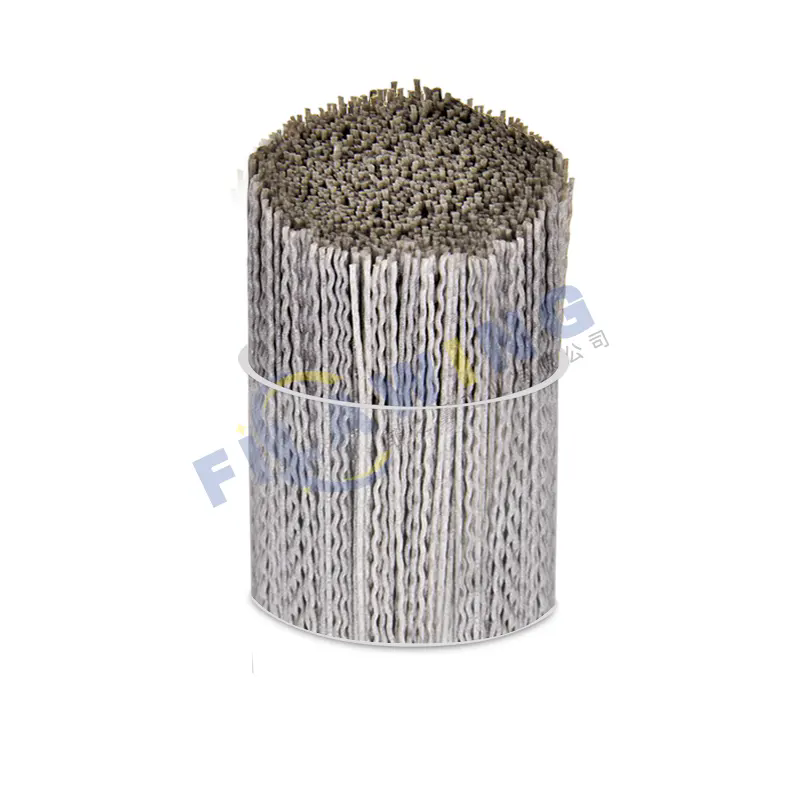The Power of Abrasive Nylon Filaments: Revolutionizing Surface Finishing and Cleaning
2025-01-04
In the world of industrial cleaning and surface finishing, precision, durability, and versatility are paramount. One material that stands out for its ability to meet these requirements is abrasive nylon filament. A unique and highly functional material, abrasive nylon filament is increasingly being used across various industries for applications ranging from cleaning to polishing and deburring.
In this blog, we’ll explore what abrasive nylon filaments are, how they work, their benefits, and the wide range of applications where they are making a significant impact.
What Are Abrasive Nylon Filaments?
Abrasive nylon filaments are specialized synthetic filaments made from nylon fibers that are embedded with abrasive particles, such as silicon carbide or aluminum oxide. These particles are evenly distributed throughout the filament, ensuring that the abrasive material is consistently available throughout its use.
These filaments are used in a variety of tools, such as brushes, pads, and other abrasive finishing products. The key difference between traditional abrasive tools and those using abrasive nylon filaments is the combination of flexibility, durability, and the ability to provide consistent, controlled abrasiveness. These filaments are typically used for tasks that require precision and a gentle touch, such as surface preparation, cleaning, deburring, and polishing.
How Do Abrasive Nylon Filaments Work?
The unique construction of abrasive nylon filaments allows them to provide effective surface finishing without damaging or scratching the underlying material. The abrasive particles within the nylon filament are bound to the surface of the fiber, and when the filaments come into contact with a surface, they gently scrape or polish it, gradually removing layers of dirt, rust, oxidation, or unwanted material.
Because of their flexibility, these filaments are able to conform to the shape of the surface they are working on, allowing for uniform treatment across complex geometries, curves, and intricate surfaces. The action of the filaments is both gentle and effective, ensuring a high-quality finish without causing damage to the substrate.
Key Benefits of Abrasive Nylon Filaments
1. Consistent and Controlled Abrasiveness
One of the major benefits of abrasive nylon filaments is their ability to provide a consistent level of abrasiveness over a prolonged period. Unlike traditional abrasives that can wear out quickly, the embedded abrasive particles in nylon filaments remain evenly distributed, maintaining a uniform surface finish for longer periods of use.
2. Flexibility and Conformability
Unlike rigid abrasive materials, abrasive nylon filaments are flexible. This allows them to adapt to the surface they are cleaning or finishing, making them ideal for complex shapes or surfaces with varying contours. The ability to conform to intricate geometries ensures that no part of the surface is neglected, resulting in an even and thorough finish.
3. Non-Damaging to Surfaces
Abrasive nylon filaments are gentle yet effective. Because the abrasive particles are evenly distributed and the filaments are flexible, they can perform cleaning, polishing, and deburring tasks without causing damage to sensitive materials. This makes them ideal for delicate finishes, such as in the automotive or aerospace industries, where surface integrity is crucial.
4. Durability and Longevity
Nylon is known for its durability and resistance to wear. Abrasive nylon filaments can withstand high friction and maintain their shape and functionality for a long time. This results in longer tool life and more cost-effective operations, as users don’t need to replace tools as frequently.
5. Versatility
Abrasive nylon filaments can be used in a variety of applications and industries. Their versatility makes them an excellent choice for both light and heavy-duty tasks. Whether it’s for cleaning, deburring, polishing, or surface preparation, abrasive nylon filaments offer an adaptable solution for many different processes.
6. Safety
Due to their ability to clean and finish surfaces without harsh chemicals or extreme abrasives, abrasive nylon filaments offer a safer alternative for both the operator and the environment. There is less risk of harming the surface, and they provide a more controlled abrasive action compared to traditional grinding or abrasive pads.
Common Applications of Abrasive Nylon Filaments
The unique properties of abrasive nylon filaments make them well-suited for a wide variety of applications. Here are some of the most common uses:
1. Surface Preparation and Cleaning
Abrasive nylon filaments are used in industrial cleaning applications where effective yet gentle surface preparation is needed. They are perfect for cleaning metal, plastic, glass, and other materials without scratching or damaging the surface. The filaments can remove rust, paint, oil, grease, and other contaminants, leaving a clean, smooth surface.
2. Deburring and Polishing
One of the most popular uses of abrasive nylon filaments is for deburring and polishing metal parts. After parts are machined or cut, sharp edges and burrs often remain. Abrasive nylon filament tools are used to gently smooth out these rough edges, providing a uniform, polished finish without altering the dimensions of the part.
3. Automotive Industry
In the automotive sector, abrasive nylon filaments are used for cleaning and preparing metal surfaces, especially in engine parts and chassis. They are also used for detailing, polishing paint, and providing a high-quality finish for parts that need to be free from contaminants and blemishes.
4. Aerospace
The aerospace industry requires the highest level of precision and surface integrity. Abrasive nylon filaments are often used in this industry to clean, deburr, and polish parts like turbine blades, landing gear, and other components that need to meet strict safety and performance standards.
5. Medical Devices
For the medical industry, precision is everything. Abrasive nylon filaments are ideal for cleaning and finishing delicate medical devices, ensuring they are free of contaminants and prepared for sterilization without compromising their quality or structure. Their gentle yet effective action makes them a preferred choice for cleaning sensitive equipment.
6. Electronics
In the electronics industry, abrasive nylon filaments are used to clean delicate components, such as circuit boards, connectors, and other parts that require a gentle touch to avoid damage. Their ability to remove dirt and oxidation without harming the surface makes them perfect for use in the production of high-quality electronics.
7. Woodworking and Furniture
Abrasive nylon filaments are also employed in woodworking applications, particularly for sanding and finishing wooden surfaces. Whether it's removing paint, smoothing rough surfaces, or polishing furniture, these filaments provide an even finish without damaging the wood.
Conclusion
Abrasive nylon filaments may be small, but they pack a punch when it comes to their utility in industrial applications. From cleaning and surface preparation to deburring and polishing, these filaments are versatile, durable, and precise, offering a wide range of benefits over traditional abrasives. Their ability to conform to complex shapes, provide controlled abrasiveness, and ensure a safe, non-damaging finish makes them an essential component in industries ranging from aerospace and automotive to medical devices and electronics.
As industries continue to demand higher efficiency and precision, abrasive nylon filaments will remain a go-to solution for surface finishing needs. With their remarkable durability, reliability, and adaptability, these filaments are revolutionizing the way we approach cleaning, polishing, and finishing tasks, ensuring quality results with every use.



